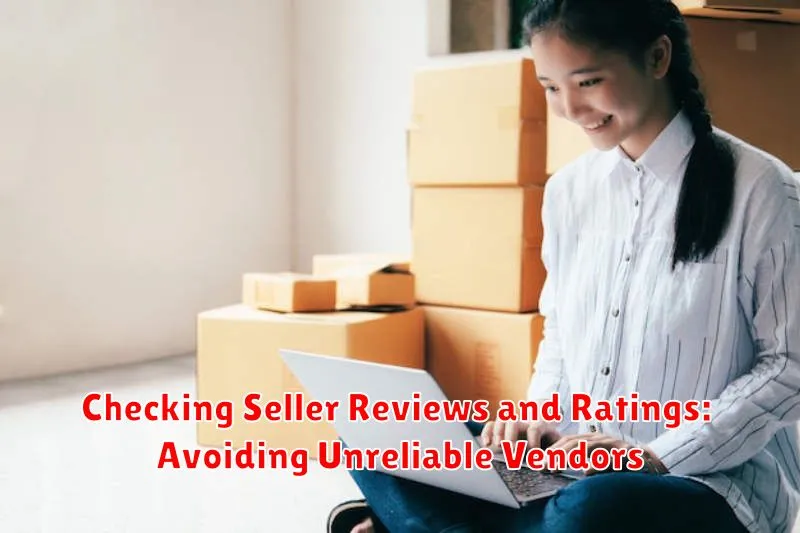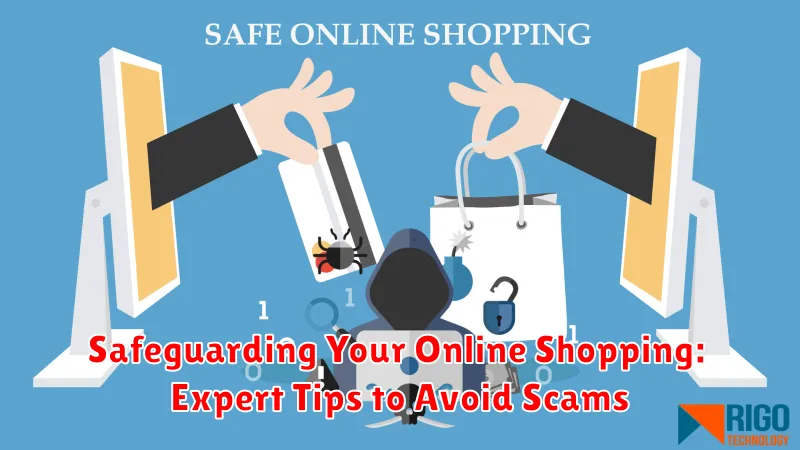In today’s digital age, online shopping offers unparalleled convenience. However, this convenience comes with inherent risks, as cybercriminals constantly devise new ways to exploit unsuspecting shoppers. Safeguarding your personal information and finances while enjoying the benefits of online shopping is crucial. This article will provide you with expert tips to identify and avoid scams, allowing you to shop with confidence and peace of mind. From recognizing phishing attempts and fraudulent websites to protecting your financial data, we’ll equip you with the knowledge to navigate the online marketplace safely.
Falling victim to an online shopping scam can result in significant financial losses and compromise your personal data. It is vital to be proactive in safeguarding yourself against these threats. By understanding the common tactics employed by scammers and implementing the expert tips outlined in this article, you can significantly reduce your risk. We will delve into secure payment methods, recognizing counterfeit products, and understanding your rights as a consumer. Learn how to avoid scams and shop securely, ensuring your online shopping experience is both enjoyable and safe.
Recognizing Common Online Shopping Scams: Red Flags to Watch Out For
Staying safe while shopping online requires vigilance. Recognizing common scam tactics is the first line of defense. Be wary of deals that seem too good to be true. Unbelievably low prices are often a lure.
Pay close attention to the website’s URL. Secure sites use “https” and display a padlock icon. Misspellings or unusual domain extensions can indicate a fraudulent site. Scrutinize seller information. A lack of contact details or a physical address is a warning sign.
Be cautious of high-pressure sales tactics. Limited-time offers and artificial scarcity are often used to manipulate buyers. Suspicious payment methods are another red flag. Scammers may insist on wire transfers or cryptocurrency payments which are difficult to trace.
Poor grammar and spelling on a website can be an indicator of a scam operation. Legitimate businesses typically maintain professional websites. Finally, unsolicited emails or messages with deals should be treated with suspicion. Avoid clicking on links from unknown sources.
Secure Payment Practices: Protecting Your Financial Information
Protecting your financial information while shopping online is paramount. Always opt for secure payment methods. Credit cards offer better fraud protection than debit cards. Consider using a virtual credit card number for an added layer of security. This masks your actual card number, minimizing risk.
Services like PayPal and Apple Pay provide secure transaction platforms. They act as intermediaries, so you don’t directly share your financial details with the merchant. Be wary of websites requesting payment through unusual methods like wire transfers or cryptocurrency, as these can be difficult to trace if something goes wrong.
Regularly monitor your bank and credit card statements for any unauthorized transactions. Report any suspicious activity immediately to your financial institution. By taking these precautions, you can significantly reduce the risk of financial fraud during online shopping.
Verifying Website Authenticity: Ensuring a Safe Shopping Environment

Before entering any personal or financial information, take time to verify the website’s authenticity. A secure website is paramount to a safe online shopping experience.
Look for the lock. A padlock icon in the address bar signifies a secure connection using HTTPS. This indicates that data transmitted between your browser and the website is encrypted, making it difficult for hackers to intercept.
Scrutinize the URL. Double-check the website address for misspellings or unusual characters, which could indicate a fake website mimicking a legitimate one. Be wary of URLs that use unfamiliar top-level domains (TLDs) other than .com, .net, or .org, unless you are certain of their legitimacy.
Check for contact information. Legitimate online retailers will provide clear contact information, including a physical address, phone number, and email address. Verify this information to ensure it is accurate and leads to a genuine business.
Read reviews and testimonials. Look for reviews and testimonials from other customers. While not foolproof, a consistent history of positive reviews can be a good indicator of a reputable online store. Be aware that overly positive reviews with little detail may be fabricated.
Protecting Your Personal Information: Avoiding Phishing and Identity Theft
Phishing attacks are designed to trick you into revealing sensitive information. Be wary of emails, texts, or pop-ups requesting personal details like passwords, credit card numbers, or social security numbers. Legitimate businesses rarely ask for such information via these channels.
Verify email addresses and URLs carefully. Phishing attempts often use addresses or URLs that look similar to real companies but with slight variations. Always double-check before clicking any links or providing information.
Be cautious of unsolicited communications. If you receive an unexpected email or message asking for personal information, treat it with suspicion. Contact the supposed sender directly through official channels to confirm its legitimacy.
Strong passwords are crucial. Use a unique, complex password for each online account, incorporating a mix of upper and lowercase letters, numbers, and symbols. Consider using a password manager to help generate and securely store your passwords.
Regularly monitor your accounts. Frequently check your bank statements, credit card bills, and online accounts for any unauthorized activity. Report any discrepancies immediately.
Shopping on Secure Networks: The Importance of Wi-Fi Safety
When shopping online, the security of the network you use is just as important as the security of the website itself. Using unsecured public Wi-Fi networks, like those found in coffee shops or airports, puts your information at risk. Hackers can potentially intercept data transmitted over these networks, including your login credentials and financial details.
Always shop online using a secure network. Your home network, protected by a strong password, is generally the safest option. If you must use public Wi-Fi, ensure it’s a legitimate network and consider using a Virtual Private Network (VPN). A VPN encrypts your internet traffic, adding an extra layer of security.
Be cautious of “free” public Wi-Fi hotspots. These unsecured networks can be easily set up by malicious actors to steal information. Verify the network name with the establishment providing it before connecting.
Understanding Buyer Protection Policies: Your Rights as a Consumer
Buyer protection policies are crucial safeguards for online shoppers. These policies, offered by payment processors, marketplaces, and even individual retailers, provide a layer of security against fraudulent sellers and unsatisfactory purchases. Understanding these policies empowers you to shop with confidence, knowing your rights are protected.
Key aspects of buyer protection policies often include:
- Purchase protection: Safeguards against items that never arrive, arrive damaged, or are significantly different from what was advertised.
- Refund guarantees: Policies that ensure you can receive a refund if eligible criteria are met.
- Dispute resolution: A process for resolving disagreements between buyers and sellers, often mediated by the platform or payment processor.
Familiarize yourself with the specific buyer protection policies of each platform you use. Policies vary, and understanding the nuances can prove vital should a problem arise. Knowing your rights under these policies is the first step in ensuring a safe and positive online shopping experience.
Checking Seller Reviews and Ratings: Avoiding Unreliable Vendors

Before committing to a purchase, thoroughly vet the seller. Seller reviews and ratings provide crucial insights into their reliability and the quality of their products or services. Take the time to read both positive and negative reviews, paying attention to recurring themes.
Look for red flags such as consistently late deliveries, products not matching descriptions, or poor customer service. A high volume of overwhelmingly positive reviews may also warrant further investigation. Some sellers employ unethical tactics to inflate their ratings.
Consider the source of the reviews. Are they primarily from verified purchasers? Are there detailed descriptions of the buyer’s experience? Genuine reviews often provide specific examples and details. Vague or generic praise should be viewed with skepticism.
Don’t rely solely on reviews from one platform. If possible, cross-reference seller information on different websites or marketplaces to get a more comprehensive picture of their reputation.
Reporting Online Scams: Taking Action Against Fraudulent Activities
Experiencing an online shopping scam can be frustrating and costly. Taking swift action is crucial to mitigate damages and help prevent others from falling victim. Reporting these scams is a vital step in combating online fraud.
Where to Report: Several avenues exist for reporting online scams. Contact your local law enforcement agency and the Federal Trade Commission (FTC). The FTC’s website offers a dedicated portal for reporting online scams and provides valuable resources for victims. You can also report the incident to the e-commerce platform where the transaction occurred. Most platforms have dedicated channels for reporting fraudulent sellers and suspicious activity.
Information to Provide: When reporting, provide as much detail as possible. This includes the seller’s information, transaction details (dates, amounts, and payment method), and any communication you had with the seller. Screenshots of the fraudulent listing, emails, or messages can serve as valuable evidence.
By reporting online scams, you contribute to a safer online marketplace. Your actions can help authorities identify and prosecute fraudulent sellers and protect other consumers from similar scams.

